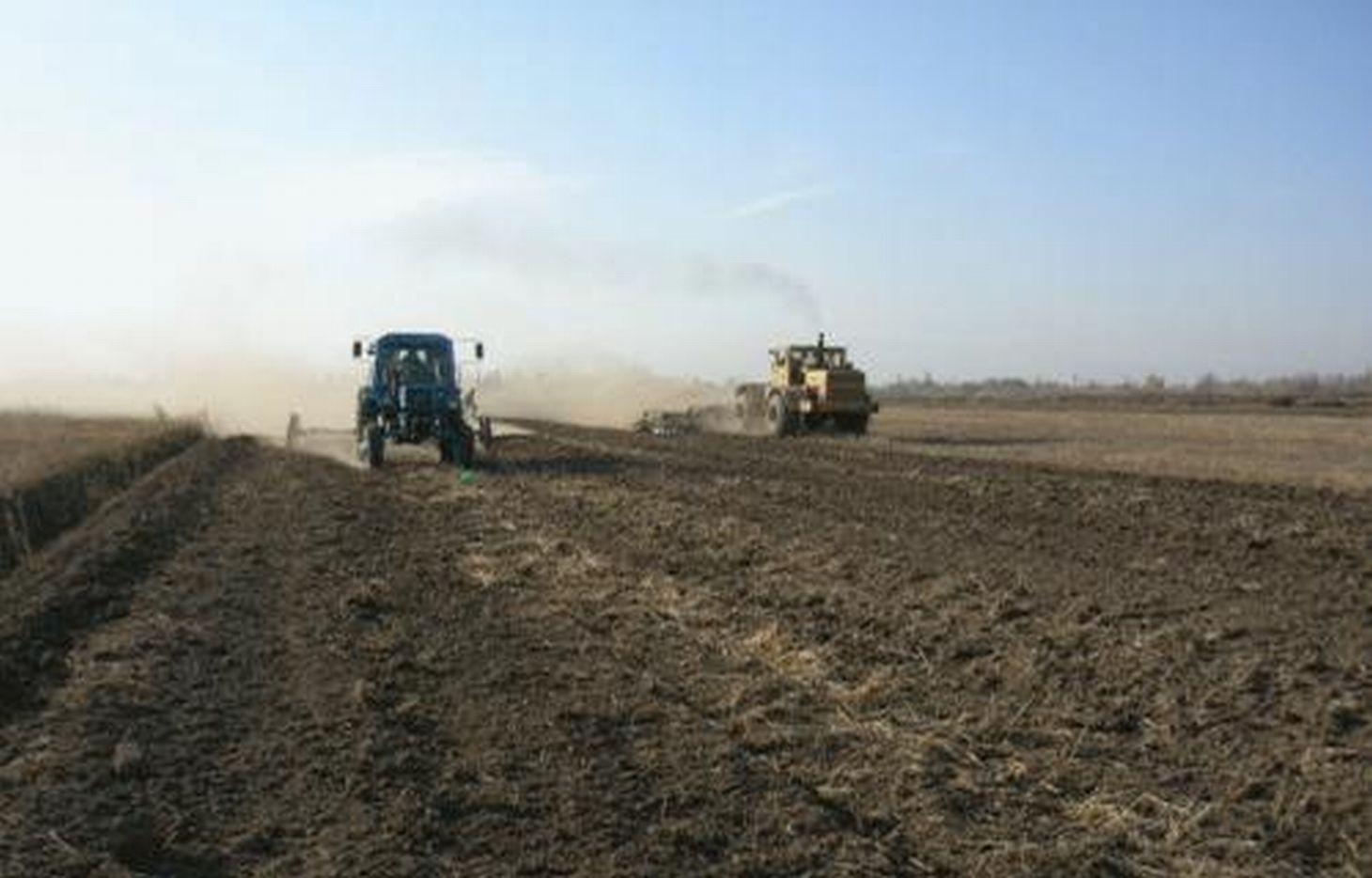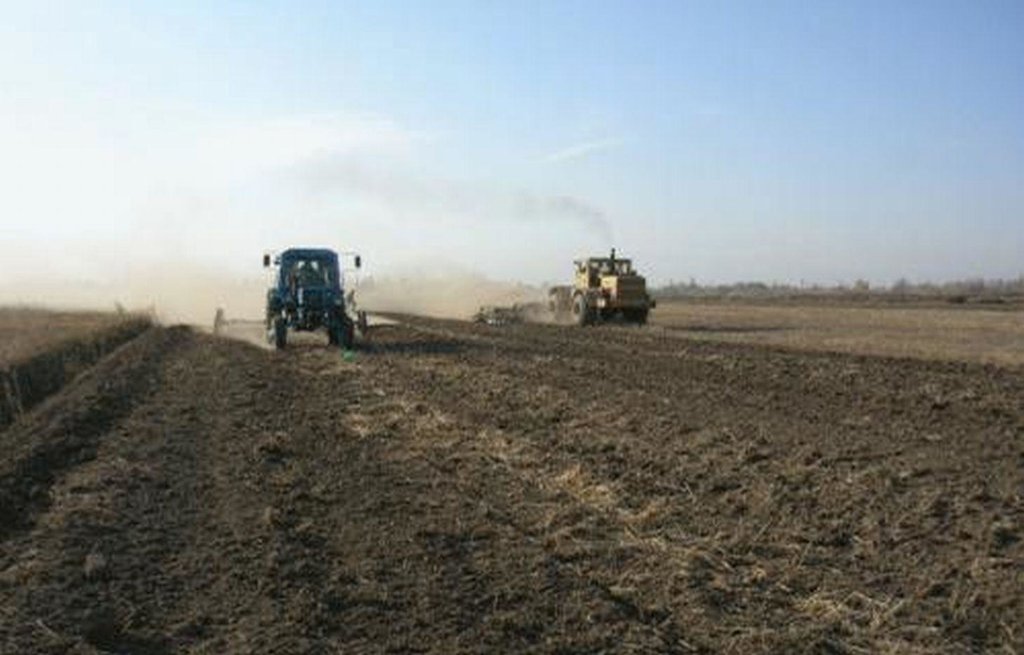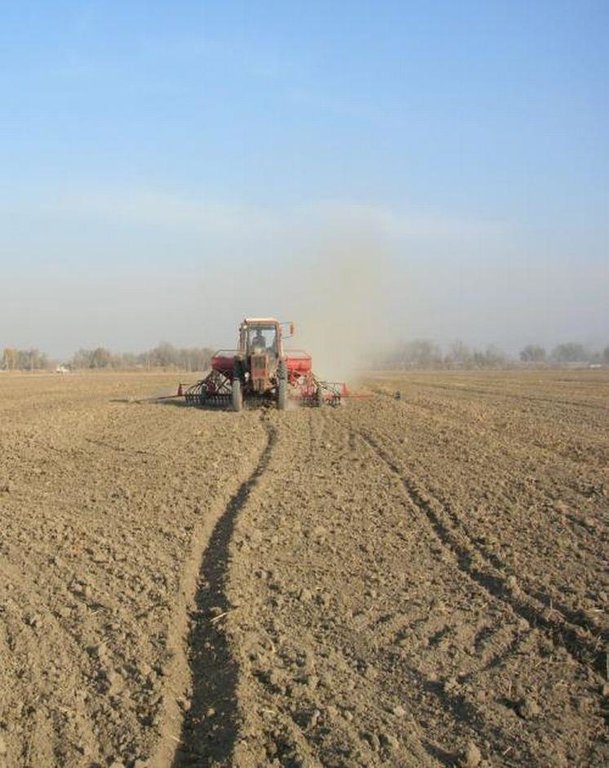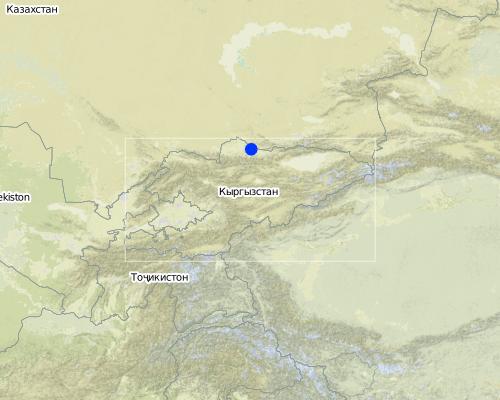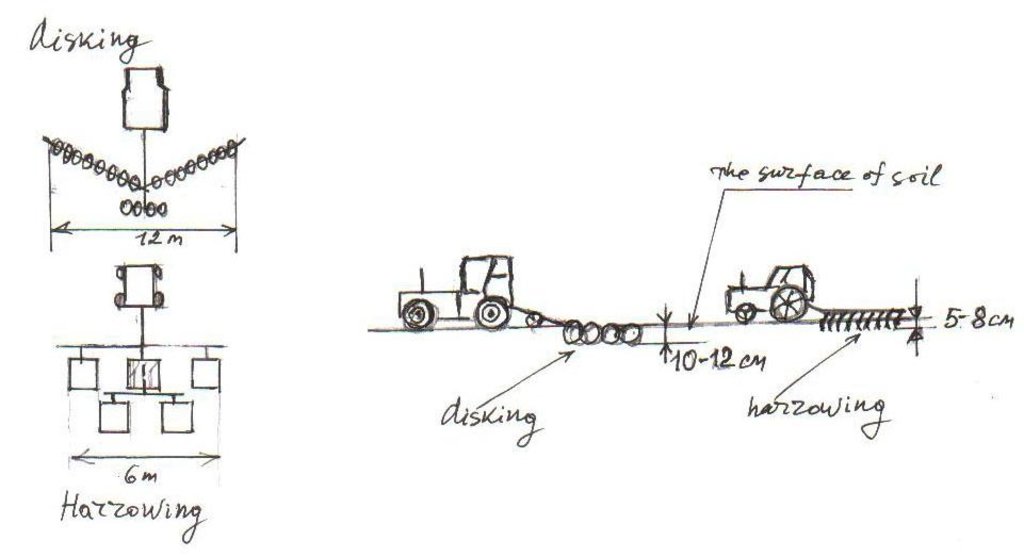Growing cereals by using minimum tillage (CACILM) [Kyrgyzstan]
- Creation:
- Update:
- Compiler: Abdybek Asanaliev
- Editor: –
- Reviewer: Alexandra Gavilano
Kyrgyzstan – Central Asian Countries Initiative for Land Management
technologies_1120 - Kyrgyzstan
View sections
Expand all Collapse all1. General information
1.2 Contact details of resource persons and institutions involved in the assessment and documentation of the Technology
SLM specialist:
Krasnojenov Petr
0 779 973 041
Seed Growers’ Association of Kyrgyzstan,
Bishkek
Name of project which facilitated the documentation/ evaluation of the Technology (if relevant)
Central Asian Countries Initiative for Land Management (CACILM I)Name of the institution(s) which facilitated the documentation/ evaluation of the Technology (if relevant)
Kyrgyz Agrarian University (Kyrgyz Agrarian University) - Kyrgyzstan1.3 Conditions regarding the use of data documented through WOCAT
When were the data compiled (in the field)?
29/08/2011
The compiler and key resource person(s) accept the conditions regarding the use of data documented through WOCAT:
Yes
2. Description of the SLM Technology
2.1 Short description of the Technology
Definition of the Technology:
A minimum tillage depth of 10-12 cm by a tractor with a ploughshare creates a friable soil layer, facilitates preservation of productive moisture until the agricultural crops’ sowing, as well as eliminates the extreme soil compaction owing to the operation of heavy machinery and tractors.
2.2 Detailed description of the Technology
Description:
In case of the minimum tillage application on a field it is necessary to critically consider the classical tillage methods for cereal cultivation. During the Soviet era the State allocated funds for the implementation of agricultural practices, considering that agriculture was subsidised by the state. Under such conditions, farmers did not have much interest in applying progressive techniques, for example minimum tillage. In the post-Soviet era, the farming conditions changed; land tenure was changed to private ownership; and agronomic practices are now covered entirely by the farmers. Implementation of the traditional moldboard ploughing at a the depth of 20-25 cm over many years led to the formation of a subsurface compact layer in the clayey soil, which prevents vertical filtration of water and air exchange, negatively impacting the life of aerobic soil microorganisms and decreasing the cereals’ yield. It resulted in the necessity of destroying such layers periodically with the help of a subsoil cultivator, attached to a plough carriage and entailing high fuel costs.
Using minimum tillage the field is cultivated at a depth of 10-12 cm by a tractor with a disker and simultaneously harrowed immediately after the harvest. Minimum tillage creates an even and loose field cover without inner capillaries through which the moisture can quickly evaporate. The productive moisture reserve at this sowing depth is 30% higher in comparison to soil preparation by usual ploughing, and therefore increasing seed germination in the field. An additional advantage of minimum tillage is lower CO2 emissions from soil in comparison with mouldboard ploughing. Through applying minimum tillage, the activity of subterranean micro fauna (earthworm, predatory beetles) improves.. Furthermore, there is no need to even the soil, which reduces the tillage number and allows for greater conservation of fuel and lubricant, as well as reducing labour costs. The ridge sowing technology is applied in CIS countries (Kazakhstan, Kyrgyzstan, Azerbaijan, Tajikistan.) in the production of wheat and other cereals. Kyrgyzstan first applied this technology with the support of the SIDA project “Support to seed development industry in Kyrgyzstan”. Further dissemination of this method was supported by the Seed Growers’ Association of Kyrgyzstan. This technology was utilized in Kyrgyzstan through the use of the Turkish seeder СBP-2,8, which forms ridges, sows and simultaneously cuts furrows to irrigate between the ridges. The ridge sowing technology creates optimal conditions for agricultural crops and provides effective furrow irrigation. This prevents excessive use of irrigation water (saving 25-30%) and irrigation erosion, which happens in the case of using flooding methods on the crop fields using common corn planters. In addition, it prevents the flooding of useful soil micro fauna, as well as saves time. Prior to irrigation or after irrigation, a tractor or agricultural machine can easily go along the irrigation furrows to spray plants with herbicides and pesticides. Ridge sowing of cereals can be implemented almost on all types of grey-brownish, grey, red, yellow soil types with middle and light mechanical composition. In addition to cereals, ridge sowing can be used for growing vegetables and legumes (including potato), as well as industrial and oil crops (sugar beet, rape, soya bean, sesame)
Depending on natural climatic conditions and biological peculiarities of the cultivated varieties, width between the ridges is about 60-70cm. 2-3 rows of seeds can be sown on the ridges with a row spacing of 15cm. Over the course of 3 years, 10 ha of land were sown by using this technology, and the wheat grain yield was not reduced in comparison to the conventional cultivation method using a corn planter. While sowing cereals with such a seeder, it is recommended to cultivate well-bushing varieties. The ridge seeder decreases the seeding rate to a minimum. The seeding rate of cereals is 100-150kg/ha instead of 200-250kg/ha when using the usual sowing method with a classical corn planter and provides additional yield of winter grain wheat up to 5 -8,3 centner/ha. Practice is documented in the frame of CACILM.
Purpose of the Technology: Eliminate soil compaction; reduce evaporation of moisture and СО2 from soil; create optimal conditions for soil micro fauna; increase yield and reduce fuel consumption costs while tilling soil
Establishment / maintenance activities and inputs: The essential element of this technology is that a farmer or farmers’ organization owns a disk tiller, which costs about 1000 USD
Natural / human environment: Minimum tillage is applied on grey-brownish soils; with a humus content of 3- 6%. “MIS” JSC is comprised of approximately 50 farmers. Over 100 ex-farmers of the “MIS” JSC received their land shares and organized the peasants’ farms (PF). All these farmers communicate with each other and exchange experiences. Therefore, both “MIS” JSC members and other farmers apply minimum tillage
2.3 Photos of the Technology
2.5 Country/ region/ locations where the Technology has been applied and which are covered by this assessment
Country:
Kyrgyzstan
Region/ State/ Province:
Kyrgyz Republic
Further specification of location:
Chui oblast, Kant rayon, Kant village
Map
×2.6 Date of implementation
If precise year is not known, indicate approximate date:
- less than 10 years ago (recently)
2.7 Introduction of the Technology
Specify how the Technology was introduced:
- through land users' innovation
Comments (type of project, etc.):
Minimum tillage has been applied since 2000.
3. Classification of the SLM Technology
3.2 Current land use type(s) where the Technology is applied

Cropland
- Annual cropping

Grazing land
Extensive grazing land:
- Semi-nomadism/ pastoralism
Main animal species and products:
Semi-nomadism / pastoralism: In summer livestock is driven to mountain pastures
Ranching: Cows are reared for milk and meat
Comments:
Major land use problems (compiler’s opinion): The use of obsolete machinery and technologies reduces soil fertility and the amount of moisture in the soil; suppresses life activity of soil micro fauna and needs high power inputs. For example, moldboard ploughing facilitates soil compaction, and using it for winter ploughing in early spring the upper fertile soil layers are washed out by melting snow and intense rains.
Major land use problems (land users’ perception): Reduction of soil fertility causing farmers to buy mineral fertilizer; reduced application of organic fertilizer due to decrease of livestock numbers; and use of dry manure as fuel.
3.3 Further information about land use
Water supply for the land on which the Technology is applied:
- full irrigation
Number of growing seasons per year:
- 1
Specify:
Longest growing period in days: 160Longest growing period from month to month: April - September
Livestock density (if relevant):
1-10 LU /km2
3.5 Spread of the Technology
Specify the spread of the Technology:
- evenly spread over an area
If the Technology is evenly spread over an area, indicate approximate area covered:
- 1-10 km2
Comments:
Total area covered by the SLM Technology is 2 m2.
3.6 SLM measures comprising the Technology

agronomic measures
- A3: Soil surface treatment
Comments:
Type of agronomic measures: minimum tillage
3.7 Main types of land degradation addressed by the Technology

physical soil deterioration
- Pc: compaction

biological degradation
- Bl: loss of soil life
Comments:
Main causes of degradation: crop management (annual, perennial, tree/shrub) (Violation of the crop rotation scheme (absence of crop rotation).), inputs and infrastructure: (roads, markets, distribution of water points, other, …) (Obsolete agricultural machinery.)
Secondary causes of degradation: other human induced causes (specify) (Habit using old land management methods), droughts (Droughts every 3 years.), governance / institutional (Weakly developed farmers’ associations.)
3.8 Prevention, reduction, or restoration of land degradation
Specify the goal of the Technology with regard to land degradation:
- reduce land degradation
Comments:
Main goals: mitigation / reduction of land degradation
4. Technical specifications, implementation activities, inputs, and costs
4.1 Technical drawing of the Technology
4.2 Technical specifications/ explanations of technical drawing
The picture shows a) soil tillage by moldboard plowing, b) scheme of minimum soil tillage
Location: “MIS” farm fields. Chui oblast
Date: 30.09.2011
Technical knowledge required for field staff / advisors: high
Technical knowledge required for land users: moderate
Main technical functions: stabilisation of soil (eg by tree roots against land slides), increase in organic matter, increase / maintain water stored in soil
Minimum tillage
Material/ species: Disker
Quantity/ density: 10 sm
Remarks: Disking and leveling with harrow
4.3 General information regarding the calculation of inputs and costs
other/ national currency (specify):
KGS som
Indicate exchange rate from USD to local currency (if relevant): 1 USD =:
40.0
Indicate average wage cost of hired labour per day:
7.00
4.5 Costs and inputs needed for establishment
| Specify input | Unit | Quantity | Costs per Unit | Total costs per input | % of costs borne by land users | |
|---|---|---|---|---|---|---|
| Equipment | Purchase of disks | pc | 1.0 | 1000.0 | 1000.0 | 100.0 |
| Equipment | machine use | 1.0 | 5.0 | 5.0 | 100.0 | |
| Total costs for establishment of the Technology | 1005.0 | |||||
4.6 Maintenance/ recurrent activities
| Activity | Type of measure | Timing/ frequency | |
|---|---|---|---|
| 1. | Disking (minimum tillage) | Agronomic | Once a year after harvesting |
| 2. | Harrowing | Agronomic | После сбора урожая |
| 3. | Harrowing | Agronomic | |
| 4. | Посев | Agronomic | Октябрь |
| 5. | Уборка | Agronomic | В период созревания зерна |
4.7 Costs and inputs needed for maintenance/ recurrent activities (per year)
| Specify input | Unit | Quantity | Costs per Unit | Total costs per input | % of costs borne by land users | |
|---|---|---|---|---|---|---|
| Labour | labour | ha | 1.0 | 45.0 | 45.0 | 100.0 |
| Equipment | machine use | ha | 344.0 | 26.5 | 9116.0 | 100.0 |
| Fertilizers and biocides | seeds | pc | 0.25 | 37.5 | 9.38 | 100.0 |
| Fertilizers and biocides | seedlings | pc | 0.5 | 50.0 | 25.0 | 100.0 |
| Total costs for maintenance of the Technology | 9195.38 | |||||
Comments:
all calculations were made on the base of 1 ha on 15 October 2011
4.8 Most important factors affecting the costs
Describe the most determinate factors affecting the costs:
Mechanical composition of soil and field slopes, types of tractors and agricultural machinery, qualification of workers
5. Natural and human environment
5.1 Climate
Annual rainfall
- < 250 mm
- 251-500 mm
- 501-750 mm
- 751-1,000 mm
- 1,001-1,500 mm
- 1,501-2,000 mm
- 2,001-3,000 mm
- 3,001-4,000 mm
- > 4,000 mm
Agro-climatic zone
- semi-arid
Thermal climate class: temperate. For 5 months the temperature is higher than 10° C.
5.2 Topography
Slopes on average:
- flat (0-2%)
- gentle (3-5%)
- moderate (6-10%)
- rolling (11-15%)
- hilly (16-30%)
- steep (31-60%)
- very steep (>60%)
Landforms:
- plateau/plains
- ridges
- mountain slopes
- hill slopes
- footslopes
- valley floors
Altitudinal zone:
- 0-100 m a.s.l.
- 101-500 m a.s.l.
- 501-1,000 m a.s.l.
- 1,001-1,500 m a.s.l.
- 1,501-2,000 m a.s.l.
- 2,001-2,500 m a.s.l.
- 2,501-3,000 m a.s.l.
- 3,001-4,000 m a.s.l.
- > 4,000 m a.s.l.
5.3 Soils
Soil depth on average:
- very shallow (0-20 cm)
- shallow (21-50 cm)
- moderately deep (51-80 cm)
- deep (81-120 cm)
- very deep (> 120 cm)
Soil texture (topsoil):
- medium (loamy, silty)
Topsoil organic matter:
- medium (1-3%)
5.4 Water availability and quality
Ground water table:
< 5 m
Availability of surface water:
good
Water quality (untreated):
good drinking water
5.5 Biodiversity
Species diversity:
- medium
5.6 Characteristics of land users applying the Technology
Off-farm income:
- less than 10% of all income
Relative level of wealth:
- average
- rich
Individuals or groups:
- individual/ household
Level of mechanization:
- mechanized/ motorized
Gender:
- men
Indicate other relevant characteristics of the land users:
Population density: 10-50 persons/km2
Annual population growth: 1% - 2%
10% of the land users are rich and own 40% of the land.
70% of the land users are average wealthy and own 50% of the land.
20% of the land users are poor and own 10% of the land.
Off-farm income specification: Renting agricultural machineries
Market orientation of production system: mixed (subsistence/ commercial, commercial/ market, commercial/ market
5.7 Average area of land owned or leased by land users applying the Technology
- < 0.5 ha
- 0.5-1 ha
- 1-2 ha
- 2-5 ha
- 5-15 ha
- 15-50 ha
- 50-100 ha
- 100-500 ha
- 500-1,000 ha
- 1,000-10,000 ha
- > 10,000 ha
Is this considered small-, medium- or large-scale (referring to local context)?
- medium-scale
5.8 Land ownership, land use rights, and water use rights
Land ownership:
- individual, not titled
Land use rights:
- communal (organized)
- individual
5.9 Access to services and infrastructure
health:
- poor
- moderate
- good
education:
- poor
- moderate
- good
technical assistance:
- poor
- moderate
- good
markets:
- poor
- moderate
- good
energy:
- poor
- moderate
- good
roads and transport:
- poor
- moderate
- good
drinking water and sanitation:
- poor
- moderate
- good
financial services:
- poor
- moderate
- good
6. Impacts and concluding statements
6.1 On-site impacts the Technology has shown
Socio-economic impacts
Production
crop production
fodder production
risk of production failure
land management
Socio-cultural impacts
food security/ self-sufficiency
Quantity before SLM:
37 ц
Quantity after SLM:
40 ц
SLM/ land degradation knowledge
conflict mitigation
Quantity before SLM:
0
Quantity after SLM:
30
Ecological impacts
Soil
soil moisture
Quantity after SLM:
20%
Biodiversity: vegetation, animals
habitat diversity
Quantity after SLM:
30%
pest/ disease control
6.2 Off-site impacts the Technology has shown
downstream siltation
Quantity after SLM:
10 %
damage on neighbours' fields
Quantity before SLM:
15 %
Quantity after SLM:
5 %
6.3 Exposure and sensitivity of the Technology to gradual climate change and climate-related extremes/ disasters (as perceived by land users)
Gradual climate change
Gradual climate change
| Season | Type of climatic change/ extreme | How does the Technology cope with it? | |
|---|---|---|---|
| annual temperature | increase | not well |
Climate-related extremes (disasters)
Meteorological disasters
| How does the Technology cope with it? | |
|---|---|
| local rainstorm | well |
Climatological disasters
| How does the Technology cope with it? | |
|---|---|
| drought | not well |
6.4 Cost-benefit analysis
How do the benefits compare with the establishment costs (from land users’ perspective)?
Short-term returns:
slightly positive
Long-term returns:
positive
How do the benefits compare with the maintenance/ recurrent costs (from land users' perspective)?
Short-term returns:
positive
Long-term returns:
very positive
6.5 Adoption of the Technology
Comments:
Comments on acceptance with external material support: Farmers did not use external help.
20% of land user families have adopted the Technology without any external material support
30 land user families have adopted the Technology without any external material support
Comments on spontaneous adoption: All 30 families voluntarily adopted the technology after visiting the demonstration field.
There is a moderate trend towards spontaneous adoption of the Technology
Comments on adoption trend: Since 2010 the agricultural cooperative “Jaiyl” applies minimum tillage on an area of 400 ha. The “SredAsiaGrope” JSC provides soil tilling and crop harvesting services and applies minimum tillage on an area of 1000 ha in Jaiyl and Panfilov rayons.
6.7 Strengths/ advantages/ opportunities of the Technology
| Strengths/ advantages/ opportunities in the land user’s view |
|---|
|
Decrease in fuel and labour costs How can they be sustained / enhanced? While there is need for cost-saving production |
|
Increase in labour productivity by minimum tillage as it allows an increase in yields at no additional labour time How can they be sustained / enhanced? awarenes raising of incereasd labour productivity due to minimum tillage |
| Increase in grain yield |
| Strengths/ advantages/ opportunities in the compiler’s or other key resource person’s view |
|---|
|
Improvement of life activity of aerobic soil microflora and soil terricolous micro fauna How can they be sustained / enhanced? If there is an advisory service |
|
Reduction in the formation of a subsurface compact layer How can they be sustained / enhanced? Avoid moldboard plowing in the future |
|
Increase in grain yield How can they be sustained / enhanced? Application of minimum tillage along with optimization of other agrotechnical methods.(optimal terms, norms and depths of sowing, irrigation regime, system of diseases and pests control, harvesting terms) |
|
Decrease in fuel and labour costs. How can they be sustained / enhanced? Continued application of minimum tillage. |
|
Increase in the farmers’ knowledge How can they be sustained / enhanced? The availability of advisory service. |
6.8 Weaknesses/ disadvantages/ risks of the Technology and ways of overcoming them
| Weaknesses/ disadvantages/ risks in the land user’s view | How can they be overcome? |
|---|---|
| Infestation will be increased | This can be controlled by applying crop rotation, mechanical eradicatation and certified seeds |
| Weaknesses/ disadvantages/ risks in the compiler’s or other key resource person’s view | How can they be overcome? |
|---|---|
| During the first years of the technology’s application, infestation of the field can be increased. | Optimizing application of herbicides in the fields |
| Quantity of soil pests, which die during the usual plowing, can be increased | Optimizing use of pesticides in the fields. |
7. References and links
7.2 References to available publications
Title, author, year, ISBN:
Отчет о производственной деятельности главного агронома Кантского МИС, 2006 год
Available from where? Costs?
Кооператив СХПК «МИС», не продается
Links and modules
Expand all Collapse allLinks
No links
Modules
No modules


